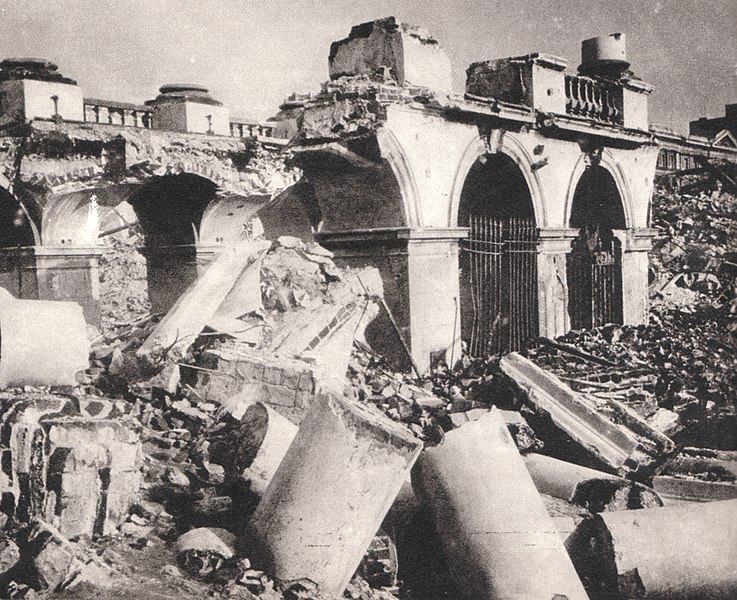President Andrzej Duda has submitted a plan to reconstruct the historic Saxon Palace (Pałac Saski) in central Warsaw, which was destroyed by the German occupiers during World War Two. The idea has received support from the prime minister, who has called for cross-party collaboration on the project.
Duda today presented the speaker of parliament, Elżbieta Witek, with a presidential bill to rebuild the Saxon Palace, as well as the nearby Brühl Palace (also destroyed in the war) and tenement houses along Królewska Street in Warsaw.
The ceremony took place on the city’s Piłsudski Square, where a small part of the Saxon Palace remains at its former location, housing the Tomb of the Unknown Soldier.
Prezydent @AndrzejDuda jest już na Placu Piłsudskiego. Dziś w tym symbolicznym miejscu przekaże na ręce Marszałka Sejmu RP projekt Ustawy o przygotowaniu i realizacji inwestycji w zakresie odbudowy Pałacu Saskiego, Pałacu Brühla oraz kamienic przy ulicy Królewskiej w Warszawie. pic.twitter.com/Ygch1xeHaA
— Kancelaria Prezydenta (@prezydentpl) July 7, 2021
The Saxon Palace, first built in 1666 and then remodelled in 1842, served as the seat of the General Staff of the Polish Armed Forces after World War One. Most of the palace was blown up by the German army after the 1944 Warsaw Uprising.
The neighbouring Brühl Palace was completed in 1642 as a residential building. The rococo palace housed Poland’s foreign ministry before World War Two, and was also destroyed by the Germans in 1944.
The square on which the two palaces sat also previously hosted the 70-metre-tall Alexander Nevsky Cathedral, a Russian Orthodox church completed in 1912 when Warsaw was still part of the Russian Empire. It was demolished just over a decade later by the authorities in newly independent Poland.

Brühl Palace in 1936

The Saxon Palace in Warsaw, destroyed by the Germans in 1944
The square remains one of Warsaw’s largest, and now serves as a site for important state visits and ceremonies, including an open-air mass by Pope John Paul II a year after ascending to the papacy. The area also hosts a number of monuments, including one marking the Smolensk air disaster of 2010.
The idea of rebuilding the palace came about in 2018, on the 100th anniversary of Poland regaining independence. On 11 November, Independence Day, Duda signed a declaration on restoring the palace as a historical monument.
Under the plan presented today, the Saxon and Brühl palaces would become seats for public institutions, including potentially the Senate, the upper house of parliament. But they would also be open to the public.
“The Saxon Palace is…inscribed in the memory of prewar Warsaw,” said presidential minister Wojciech Kolarski. It “symbolised the Second Polish Republic”, he added, referring to the the interwar Polish state established in 1918 and which existed until the German invasion of 1939.
He said that reconstruction would serve as “testimony to the continuity of our history” as well as “an expression of the construction of a modern Republic of Poland”.
Public debate about the reconstruction of the sites around the Saxon Palace has been underway since the 1940s. According to Kolarski, these efforts were torpedoed by Poland’s communist authorities because the buildings symbolised the institutions of the independent interwar Polish state.
In 2012 a foundation, Saski 2018, was established to campaign for the rebuilding of the western face of the palace. Reconstruction was also floated by the government as part of the recently unveiled “Polish Deal” economic stimulus package.
“We want to develop Polish museums. We will expand castles and palaces, the Saxon Palace,” said Jarosław Kaczyński, chairman of the ruling Law and Justice (PiS) party, while announcing the package.
The idea has, however, been met with scepticism from the opposition. In 2019, Warsaw’s mayor Rafał Trzaskowski, now deputy leader of the Civic Platform (PO) party, told Rzeczpospolita that rebuilding the palace was “not the most urgent investment in Warsaw” and could “disturb the urban space”.
At today’s ceremony, however, Duda expressed hope that the rebuilding of the palace could be an “investment beyond all political divisions”, reports Polsat News.
Speaking alongside him, Prime Minister Mateusz Morawiecki likewise called for “cross-party collaboration that will unite all Poles”. He said that the rebuilt Saxon Palace could “become the beating heart of the reborn Third Republic of Poland, a story about the Polish soul – let’s write this story together.”
During his speech, Morawiecki called the destruction of the palaces – as well as much of the rest of Warsaw – “a planned act of savage barbarism carried out by the Germans” to take “revenge against Warsaw” for the uprising.
Main image credit: Saski360 (press materials)

Maria Wilczek is deputy editor of Notes from Poland. She is a regular writer for The Times, The Economist and Al Jazeera English, and has also featured in Foreign Policy, Politico Europe, The Spectator and Gazeta Wyborcza.




















